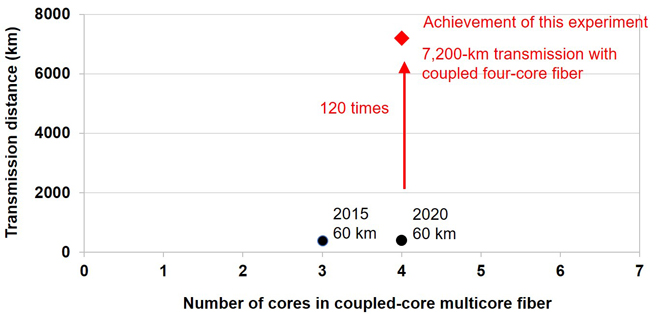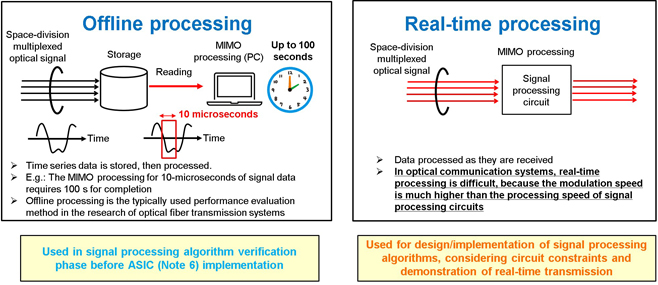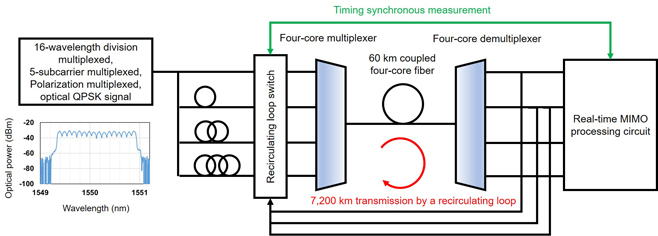 Print
Print
- Advanced Technology Laboratories
World’s first successful 7,200 km coupled multicore fiber transmission experiment by real-time MIMO signal processing method
~Expectations for an early implementation of space-division multiplexing optical signal transmission systems~
June 24, 2021
KDDI Research, Inc.
Osaka University
KDDI Research, Inc. (Head office: Fujimino, Saitama; herein referred to as “KDDI Research”) and the National University Corporation, Osaka University (Head office: Suita, Osaka, herein referred to as “Osaka University”) have developed a real-time signal processing technology using the multiple-input and multiple-output (MIMO) signal processing method (Note 1). Using a coupled four-core fiber (Note 2) with the same diameter as the existing fiber, a 7,200 km real-time transmission, 120 times longer than the previous transmission distance, was achieved (Note 3).

Fig. 1—Experimental results of coupled-core multicore fiber transmission by the real-time multiple-input multiple-output (MIMO) signal processing
【Background】
With the introduction of the futuristic concept dubbed as “Beyond 5G/6G Era”, much larger and diverse sets of data are expected to flow through communication networks than ever before, requiring an essential increase in the transmission capability and distance of optical fiber communication supporting those networks. In conventional optical fiber (single-core/single-mode fiber) transmission systems, the transmission capacity is generally expanded by multiplexing many wavelengths; however, the transmission capacity is still limited by the optical input power to a single core and interference between signals in the fiber, . To overcome this limitation, many countries, worldwide, are investing in the research and development (R&D) in “space-division multiplexing,” including multicore fiber, which allocates multiple cores in the fiber.
To date, in the R&D of coupled-core multicore optical fiber transmission, the transmission performance has been evaluated using offline signal processing methods. In these methods, the optical signals extracted from each core are converted to electrical signals and stored in an oscilloscope. The stored data are then read by a computer and MIMO processed on a CPU over a period of time. However, with these methods, an optical signal extracted from the cores spanning only over a short time-interval can be recovered from the original data. Therefore, the development of real-time MIMO signal processing is required for the practical deployment and performance evaluation of coupled-core multicore fiber transmission systems.
【Research Results】
Through collaboration with NEC Platforms Ltd., KDDI Research and Osaka University developed a new real-time MIMO signal processing circuit. Using wavelength-division multiplexed dual polarization quadrature phase shift keying (DP-QPSK) signals (Note 4), a real-time transmission over a 7,200 km coupled four-core fiber, 120 times greater than the previous world-record transmission distance, was achieved (Note 5) for the first time.

Fig. 2—Offline and real-time signal processing
In the newly developed real-time MIMO signal processing circuit, the MIMO signal processing algorithm implemented previously through a CPU, was fed to multiple real-time circuits (field programmable gate array—FPGA (Note 7)) connected by optical transceivers, using parallel signal processing techniques. Additionally, the real-time MIMO signal processing circuit was timing-synchronized accurately with an optical signal after transmission through a recirculating loop used for long-haul transmission experiments. Using these techniques, the evaluation of real-time performance was realized even over 7,200 km of transmission distance.

Fig. 3—7,200-km coupled-core four-core fiber transmission experiment through real-time MIMO signal processing
For the practical deployment of space-division multiplexing optical transmission systems, the development of various technologies to achieve stable operation is required. The outcomes of this research may contribute to accelerating development. To meet the demand for high-capacity data communication, we will continue to promote the research and development of optical fiber transmission technologies.
These results were presented as a post-deadline paper at the Optical Fiber Communication Conference & Exposition (OFC 2021) , the largest international conference on optical communication systems in the world held on June 6–11 (Note 8). This work was partially supported by the Ministry of Internal Affairs and Communications (MIC)/Research and Development of Innovative Optical Network Technology for a Novel Social Infrastructure (JPMI00316).
■ KDDI Research’s initiatives
KDDI and KDDI Research formulated “KDDI Accelerate 5.0”, a concept of a next-generation society envisioned for 2030, and summarized how it can be accomplished in “Beyond 5G/6G White Paper” in terms of the “Future Image” and “Technologies” required to create an ecosystem that spurs innovation. To develop a new lifestyle, the two companies will continue to invest in R&D on seven different technologies and an orchestration technology that links them together. The results presented in this study correspond to one of the seven technologies of the “Network.”
(Note 1) MIMO—multiple-input multiple-output signal processing
In a coupled-core multicore optical fiber, the optical signals that propagate through multiple cores leak to the other cores. MIMO signal processing is a technique that removes leakage signals on the receiver side.
(Note 2) Standard-diameter coupled four-core optical fiber
A multicore fiber is a single optical fiber with multiple cores to transmit different optical signals simultaneously. Based on the existence of interferences between cores, a multicore fiber is classified as coupled and uncoupled. Since the cores of the coupled-core multicore fiber can be allocated close to each other, they can have the same diameter as the existing fiber. However, this causes interference between the cores. To handle each core as an independent transmission path, this interference must be removed through the MIMO method of signal processing on the receiver side. As the four-core multicore fiber used in this experiment has the same diameter as the existing fiber (125 μm), it is possible to build coupled-core four-core fiber cables with existing infrastructure, which may contribute to the early implementation of this technology.
(Note 3) This is the world’s first successful coupled-core multicore fiber 7,200-km transmission experiment using the real-time MIMO signal processing method (according to KDDI Research’s survey on June 24, 2021)
(Note 4) DP-QPSK modulation technique: the dual-polarization quadrature phase shift keying (DP-QPSK) modulation technique assigns a 4-bit information to a symbol using two orthogonal polarizations and four optical phases (0°, 90°, 180°, and 270°).
(Note 5) 7,200 km real-time transmission experiment
In this experiment, a signal with a symbol rate of 2.048 GHz was polarization-multiplexed, five-subcarrier-multiplexed, and QPSK-modulated (32.64 Gbps). This signal was multiplexed at 16 wavelengths over a bandwidth of 200 GHz. This wavelength-multiplexed signal was spatially multiplexed and transmitted using four optical paths (coupled four-core fiber). Assuming an error correction code (a 25.5 % overhead), a total transmission capacity of 2.088 Tbps was achieved. (1 Tera unit = 1012 units = 103 Giga units)
(Note 6) Application specific integrated circuit (ASIC).
A generic term referring to the integrated circuits designed and manufactured for a specific purpose.
(Note 7) FPGA—Field programmable gate array
A type of integrated circuit with a freely programmable internal circuit configuration.
(Note 8) Post-deadline paper
Papers can be submitted after the regular paper submission deadline. The papers were carefully reviewed during the conference, and only highly ranked papers were accepted.
※The information contained in the articles is current at the time of publication.Products, service fees, service content and specifications, contact information, and other details are subject to change without notice.